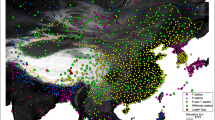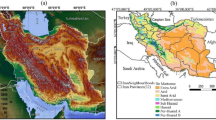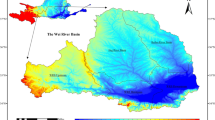Abstract
Short-term climate reconstruction, i.e., the reproduction of short-term (several decades) historical climatic time series based on the relationship between observed data and available longer-term reference data in a certain area, can extend the length of climatic time series and offset the shortage of observations. This can be used to assess regional climate change over a much longer time scale. Based on monthly grid climate data from a Coupled Model Inter-comparison Project phase 5 (CMIP5) dataset for the period of 1850–2000, the Climatic Research Unit (CRU) dataset for the period of 1901–2000 and the observed data from 53 meteorological stations located in the Tianshan Mountains region (TMR) of China during the period of 1961–2011, we calibrated and validated monthly average temperature (MAT) and monthly accumulated precipitation (MAP) in the TMR using the delta, physical scaling (SP) and artificial neural network (ANN) methods. Performance and uncertainty during the calibration (1971–1999) and verification (1961–1970) periods were assessed and compared using traditional performance indices and a revised set pair analysis (RSPA) method. The calibration and verification processes were subjected to various sources of uncertainty due to the influence of different reconstructed variables, different data sources, and/or different methods used. According to traditional performance indices, both the CRU and CMIP5 datasets resulted in satisfactory calibrated and verified MAT time series at 53 meteorological stations and MAP time series at 20 meteorological stations using the delta and SP methods for the period of 1961–1999. However, the results differed from those obtained by the RSPA method. This showed that the CRU dataset produced a low degree of uncertainty (positive connection degree) during the calibration and verification of MAT using the delta and SP methods compared to the CMIP5 dataset. Overall, the calibrated and verified MAP had a high degree of uncertainty (negative connection degree) regardless of the dataset or reconstruction method used. Therefore, the reconstructed time series of MAT for the period of 1850 (or 1901)–1960 based on the CRU and CMIP5 datasets using the delta and SP methods could be used for further study. The results of this study will be useful for short-term (several decades) regional climate reconstruction and longer-term (100 a or more) assessments of regional climate change.
Similar content being viewed by others
References
ASCE Task Committee on Application of Artificial Neural Networks in Hydrology. 2000. Artificial neural networks in hydrology I: hydrology application. Journal of Hydrologic Engineering 5(2): 124–137.
Beale M H, Hagan M T, Demuth H B. 2015. Neural Network Toolbox User’s Guide. Natick: The Mathworks Press, 1–906.
Bradley R S, Jones P D. 1994. Climate Since A.D. 1500. London: Routledge Press, 511–537.
Cannas B, Fanni A, See L, et al. 2006. Data preprocessing for river flow forecasting using neural networks: Wavelet transforms and data partitioning. Physics and Chemistry of the Earth 31(18): 1164–1171.
Chen H, Xu C Y, Guo S. 2012. Comparison and evaluation of multiple GCMs, statistical downscaling and hydrological models in the study of climate change impacts on runoff. Journal of Hydrology, 434–435: 36–45.
Esper J, Cook E R, Schweingruber F H. 2002. Low-frequency signals in long tree-ring chronologies for reconstructing past temperature variability. Science 295(5563): 2250–2253.
Fang K Y, Gou X H, Chen F H. 2012. Large-scale precipitation variability over Northwest China inferred from tree rings. Journal of Climate 25: 1357–1357.
Gaur A, Simonovic S P. 2017a. Accessing vulnerability of land-cover types to climate change using physical scaling downscaling model. International Journal of Climatology 37(6): 2901–2912.
Gaur A, Simonovic S P. 2017b. Extension of physical scaling method and its application towards downscaling climate model based near surface air temperature. International Journal of Climatology 37(8): 3353–3366.
Ghosh K G. 2018. Analysis of rainfall trends and its spatial patterns during the last century over the Gangetic West Bengal, Eastern India. Journal of Geovisualization and Spatial Analysis 2: 15, doi: 10.1007/s41651-018-0022-x.
Gupta H V, Sorooshian S, Yapo P O. 1999. Status of automatic calibration for hydrologic models: comparison with multilevel expert calibration. Journal of Hydrologic Engineering 4(2): 135–143.
Hao Z H, Li L, Xu Y. 2009. Study on Delta-DCSI downscaling method of GCM output. Journal of Sichuan University (Engineering Science Edition) 41(5): 1–7. (in Chinese)
Harris I, Jones P D, Osborn T J, et al. 2014. Updated high-resolution grids of monthly climatic observations-the CRU TS3.10 dataset. International Journal of Climatology 34(3): 623–642.
Hauduc H, Neumann M B, Muschalla D, et al. 2015. Efficiency criteria for environmental model quality assessment: A review and its application to wastewater treatment. Environmental Modelling & Software 68: 196–204.
Hay L E, Wilby I L, Leavesley G H. 2000. A comparison of delta change and downscaled GCM scenarios for three mountainous basins in the United States. Journal of the American Water Resource Association 36(2): 387–397.
Hu R J. 2004. Physical Geography of the Tianshan Mountains in China. Beijing: China Environmental Science Press, 139–142. (in Chinese).
Huang Y, Yan Q, Zhang C. 2018. Spatial-temporal distribution characteristics of PM 2.5, in China in 2016. Journal of Geovisualization and Spatial Analysis 2(2): 1–18.
Klippel L, Krusic P J, Brandes R, et al. 2018. A 1286-year hydro-climate reconstruction for the Balkan Peninsula. Boreas 47(4): 1218–1229.
Levenberg K. 1944. A method for the solution of certain non-linear problems in least squares. The Quarterly of Applied Mathematics 2: 164–168.
Li X M, Li L H, Wang X X, et al. 2013. Reconstruction of hydrometeorological time series and its uncertainties for the Kaidu River Basin using multiple data sources. Theoretical and applied climatology 113: 45–62.
Li X M, Gao P, Li Q, Tang H. 2016. Muti-paths impact from climate change on snow cover in Tianshan Mountainous area of China. Advance in Climate Change Research 12(4): 303–312. (in Chinese).
Liu X K, Rao Z G, Zhang X J, et al. 2015. Variations in the oxygen isotopic composition of precipitation in the Tianshan Mountains region and their significance for the Westerly circulation. Journal of Geographical Sciences 25(7): 801–816.
Marquardt D. 1963. An algorithm for least-squares estimation of nonlinear parameters. SIAM Journal on Applied Mathematics 11(2): 431–441.
Misra V, DiNapoli S M, Bastola S. 2012. Dynamic downscaling of the twentieth-century reanalysis over the southeastern United States. Regional Environment Change 13: 15–23.
Moriasi D N, Arnold J G, van Liew M W, et al. 2007. Model evaluation guidelines for systematic quantification of accuracy in watershed simulations. Transactions of the American Society of Agricultural and Biological Engineers 50(3): 885–900.
Nash J E, Sutcliffe J V. 1970. River flow forecasting through conceptual models Part 1: A discussion of principles. Journal of Hydrology 10(3): 282–290.
Nourani V, Komasi M, Mano A. 2009. A multivariate ANN-wavelet approach for rainfall-runoff modeling. Water Resources Management 23: 2877–2894.
Pi H, Sharratt B, Feng G, et al. 2017. Evaluation of two empirical wind erosion models in arid and semi-arid regions of China and the USA. Environmental Modelling & Software 91: 28–46.
Schimek M G, Turlach B A. 2000. Additive and generalized additive models. In: Schimek M G. Smoothing and Regression: Approaches, Computation, and Application. New York: Wiley Press, 277–327.
Shen J, Zhang E L, Xia W L. 2001. Records from lake sediments of the Qinghai Lake to mirror climatic and environmental changes of the past about 1000 years. Quaternary Sciences 21(6): 508–514.
Shen S S P, Clarke G, Shen B W, et al. 2019. Spatiotemporal variations of the twentieth century Tibetan Plateau precipitation based on the monthly 2.5° reconstructed data. Theoretical and Applied Climatology 135: 71–83.
Shi Y, Shen Y, Kang E, et al. 2007. Recent and future climate change in northwest China. Climate Change 80: 379–393.
Srinivasulu S, Jain A. 2006. A comparative analysis of training methods for artificial neural network rainfall-runoff models. Applied Soft Computing 6: 295–306.
Su M R, Yang Z F, Chen B, et al. 2009. Urban ecosystem health assessment based on energy and set pair analysis—a comparative study of typical Chinese cities. Ecological Modelling 220(18): 2341–2348.
Taylor K E, Stouffer R J, Meehl G A. 2012. A summary of the CMIP5 experiment design. Bulletin of the American Meteorological Society 93(4): 485–498.
Harris I C, Jones P D. 2020. CRU TS4.03: Climatic Research Unit (CRU) Time-Series (TS) version 4.03 of high-resolution gridded data of month-by-month variation in climate (Jan. 1901-Dec. 2018). [2020-01-22]. Centre for Environmental Data Analysis, doi: 10.5285/10d3e3640f004c578403419aac167d82.
Wang G Q, Zhao K Q, Zhen X J. 2004. Application of set pair analysis to fuzzy predictors of multiple regression weather forecast models. Bulletin of Science and Technology 20(2): 151–155. (in Chinese).
Wang H Q, Chen F, Ermenbaev B, et al. 2017. Comparison of drought-sensitive tree-ring records from the Tien Shan of Kyrgyzstan and Xinjiang (China) during the last six centuries. Advances in Climate Change Research 8(1): 18–25.
Wang M W, Wei D F, Li J, et al. 2014. A novel clustering model based on set pair analysis for the energy consumption forecast in LI Xuemei et al.: Performance and uncertainty analysis of a short-term climate reconstruction … China. Mathematical Problems in Engineering 2014(1): 1–8, doi: 10.1155/2014/191242.
Wang W S, Xiang H L, Li Y Q, et al. 2008. A new approach to annual runoff classification based on set pair analysis. Journal of Sichuan University (Engineering Science Edition) 40(5): 1–6. (in Chinese).
Wang W S, Jin J L, Ding J, et al. 2009. A new approach to water resources system assessment-set pair analysis method. Science in China Series E: Technological Sciences 52(10): 3017–3023.
Wang W S, Li Y Q. 2012. Hazard degree assessment of landslide using set pair analysis method. Natural Hazards 60(2): 367–379.
Wei W S, Yuan Y J, Yu S L, et al. 2008. Climate change in recent 235 years and trend prediction in Tianshan Mountainous area. Journal of Desert Research 28(5): 803–808. (in Chinese).
Wood S N. 2000. Modelling and smoothing parameter estimation with multiple quadratic penalties. Journal of the Royal Statistical Society: Series B (Statistical Methodology) 62(2): 413–428.
Wu Z T, Zhang H J, Krause C M, et al. 2010. Climate change and human activities: a case study in Xinjiang, China. Climatic Change 99: 457–472.
Yan F, Xu K, Li D, et al. 2017. A novel hazard assessment method for biomass gasification stations based on extended set pair analysis. PLoS ONE 12(9): e0185006.
Yang B, Braeuning A, Johnson K R, et al. 2002. General characteristics of temperature variation in China during the last two millennia. Geophysical Research Letters 29(9): 1029–1040.
Yang J J, Zhou J Z, Liu L, et al. 2008. Similarity Measures between Connection Numbers of Set Pair Analysis. In: Sun F, Zhang J, Tan Y, et al. Advances in Neural Networks - ISNN 2008. ISNN 2008. Lecture Notes in Computer Science, Vol. 5263. Berlin, Heidelberg: Springer, 63–68.
Yao T, Masson-Delmotte V, Gao J, et al. 2013. A review of climatic controls on delta 18O in precipitation over the Tibetan Plateau: observations and simulations. Review of Geophysics 51(4): 525–548.
Ye Y C, Wu Y L. 2000. The set pair analysis for the comprehensive evaluation of mine operation state. Metal Mine 6: 23–33. (in Chinese).
Zhang F Y, Ahmad S, Zhang H Q, et al. 2016a. Simulating low and high streamflow driven by snowmelt in an insufficiently gauged alpine basin. Stochastic Environmental Research and Risk Assessment 30: 59–75.
Zhang F Y, Bai L, Li L H, et al. 2016b. Sensitivity of runoff to climatic variability in the northern and southern slopes of the Middle Tianshan Mountains, China. Journal of Arid Land 8(5): 681–693.
Zhang X T, Li X M, Li L H, et al. 2019. Environmental factors influencing snowfall and snowfall prediction in the Tianshan Mountains, Northwest China. Journal of Arid Land 11(1): 15–28.
Zhao F F, Xu Z X. 2007. Comparative analysis on downscaled climate scenarios for headwater catchment of Yellow River using SDS and Delta methods. Acta Meteorologica Sinica 65(4): 653–662. (in Chinese).
Zhao K Q. 1989. Set pair and set pair analysis-a new concept and systematic analysis method. In: Proceedings of the National Conference on System Theory and Regional Planning. Baotou, China, 87–91. (in Chinese).
Zhao K Q, Xuan A L. 1996. Set pair theory-a new theory method of non-define and its applications. Systems Engineering 14(1): 18–23. (in Chinese).
Zhou J X, Li X M, Chen L, et al. 2007. Updating methods for dynamic assessment of ecological footprint-a case study of Wuhan City. Resources Science 29(3): 111–116. (in Chinese)
Acknowledgements
This work was financially supported by the National Natural Science Foundation of China (41401050, 41761014), the Foundation of A Hundred Youth Talents Training Program of Lanzhou Jiaotong University, and the Discovery Grant of Natural Sciences and Research Council of Canada. We acknowledge the Coupled Model Inter-comparison Project phase 5 (CMIP5) of the Program for Climate Model Diagnosis and Inter-comparison (PCMDI) and the World Climate Research Programme (WCRP), for collecting and archiving the model output and organizing the analysis of a multi-model dataset. We also acknowledge the help of Professor Slobodan P SIMONOVIC and the members of his research laboratory from the Facility for Intelligent Decision Support (FIDS) in Western University, Canada.
Author information
Authors and Affiliations
Corresponding author
Rights and permissions
About this article
Cite this article
Li, X., Simonovic, S.P., Li, L. et al. Performance and uncertainty analysis of a short-term climate reconstruction based on multi-source data in the Tianshan Mountains region, China. J. Arid Land 12, 374–396 (2020). https://doi.org/10.1007/s40333-020-0065-y
Received:
Revised:
Accepted:
Published:
Issue Date:
DOI: https://doi.org/10.1007/s40333-020-0065-y




